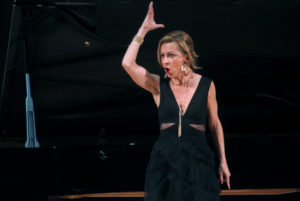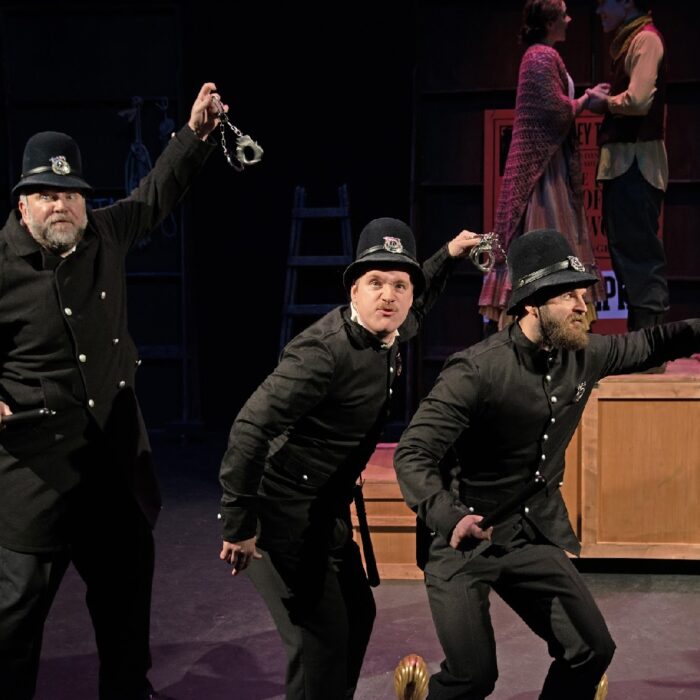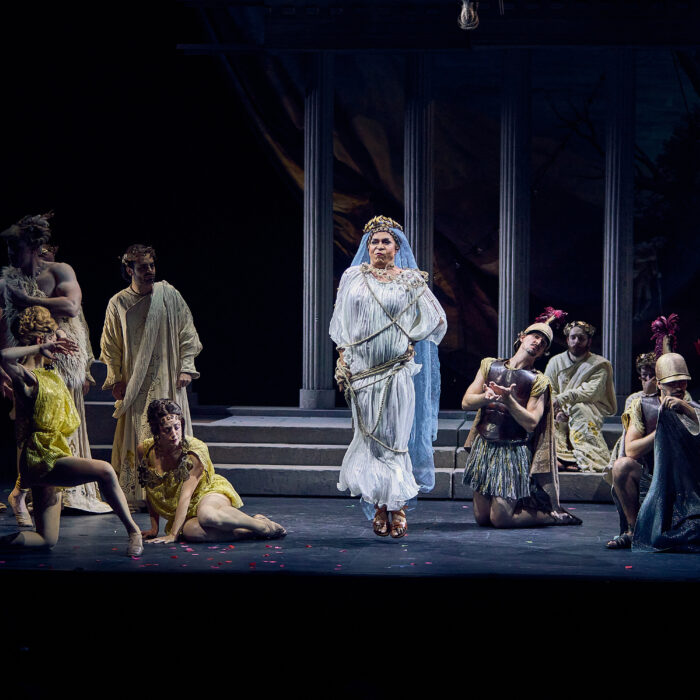
Recital Review: Natalie Dessay Marvels And Shows A Sensitive Side In Her Return To Carnegie Hall
By Francisco SalazarFor years Natalie Dessay dominated the operatic scene with her charisma, acting chops, and virtuosic voice. But in 2013, the French soprano quit the operatic scene and dedicated herself to recitals, plays, and musicals. The soprano has been outspoken for her displeasure of the opera world and her critics have noted that she no longer had a voice to sing the repertoire.
However, on Wednesday, April 26, the soprano returned to Carnegie Hall with that same blazing charisma and an uncanny musical sensibility. The voice may no longer have the same flexibility or a blossoming top that made her a perennial crowd favorite, but what it does have is strength and power to fill the massive Carnegie Hall auditorium.
The Germans
Dessay chose to open the first half of the concert with German composers. All the works, save for the first selection, were in German. When she walked out to the stage in a long black gown with her pianist and long-time collaborator Philippe Cassard, the soprano greeted her audience with an improvised moment. Cassard began playing from a Mozart sonata and Dessay turned to the audience questioning what was going on. It elicited the intended laughter before Cassard turned to “Deh vieni, non Tardar” from “Le Nozze di Figaro.” This may have been the only ill-advised piece in the program as Dessay sounded a bit uncomfortable with her top register and the sweetness of her timbre is long gone for this aria.
However, once she began her Schubert cycle, it was evident that this was an artist’s whose experience and maturity allowed her to really tell the story of these five selections. It all started with “Geheimes” based on Goethe’s text. Here she sang with a light touch as she played with the text, creating a mysterious aura.
The following piece was “Die Junge Nonne.” This haunting melody saw Dessay begin with a piano before slowly increasing her volume and crescendoing to a fortissimo. Here she exhibited all her vocal power and really showcased the various emotions of the nun described in the poem. One felt the fear and trembling that Schubert intended for the piece. And yet in the repeated “Hallelujah’s” Dessay increasingly quieted and faded into nothingness.
The “Lieder der Mignon” saw Dessay quietly caressing each line of yearning. The sweet timbre had a nostalgic quality that emitted the suffering of Mignon. Her vibrato shimmered with a slow decrescendo. But in the middle section that torment and suffering came out ever so quickly. By the end, the voice became but a silent breeze.
“Suleika” had a playful feel and once again Dessay lightened her vocal resources. It was a sweet contrast to the previous two pieces and Cassard also accompanied with refinement throughout Schubert’s rhythmic passages.
But the highlight of the cycle was “Gretchen am Spinnrade.” The pieces, which convey’s Gretchen’s madness from “Faust,” saw Dessay at her most dramatic. Cassard conveyed the spinning wheel with his steady sixteenth notes, the sound quiet and creepy.Dessay also started quietly evoking the disturbance in this woman. Here she was able to show a darker color to her voice. She began to crescendo as the line repeated and once again turned to the pianissimo right as you sensed an imminent eruption. However, after two repetitions, the singing gained strength and by the end of the piece, she crescendoed alongside Cassard to a fortissimo letting out all her vocal power and emotional weight. It was a showstopper and it showed Dessay’s true dramatic prowess.
Dessay then turned to Mozart with “Ach, ich fühl’s” from “Die Zauberflöte.” Dessay spun each line with delicacy and care. As the text notes, this a lament and in Dessay’s interpretation, she really captured the yearning that Pamina is feeling during this aria.
To close the first half of the program, Dessay sang a cycle by “Hans Pfitzner” entitled “Alte Weisen.” This was a cycle that really allowed Dessay to play on stage and act. She twirled her hands, pointed to the audience and made various facial expressions, all while portraying a set of eight women. And musically there were numerous memorable moments from Cassard holding out the final note of “Singt mein Schatz ein Fink” and connecting it to “Röschen biss de Apfel an” to Dessay turning from the coquettish colors of the first song “Mir glanzen di Augen” to the playful character of “Ich Fürcht nit Gespenster.” There was a sweet color that quickly darkened.
The gentleness in “Wandl’ich in dem Morgentau” was unmatched as she depicted the character’s journey through the dew. Dessay changed vocal colors as the music required always staying in character. As noted “Singt mein Schatz ein Fink” was connected to “Rosechen biss de Apfel” and Dessay masterfully went through the devilish coloratura runs in that piece to the darker hue of the following song. “Tretet ein, hoher krieger” had a march-like quality and both Dessay and Cassard emphasized the rhythm in this piece which is a call to a warrior. And the final “Wie glänzt der helle Mond” began with a calmer color bringing to the forefront that distance and cold. Toward the end, Dessay’s sound faded into the distance leaving the audience in expectation of more. But that was to come in the second half of the program.
The French
In a magenta gown, Dessay walked onstage in the second half with a slight cough. However, she shrugged it off. Noticing that the audience had not completely settled into their seats, she gestured to the audience to quiet down. It was a moment of levity that viewers took quite well.
Beginning the program was “Chanson perpétuelle” by Chausson. The piece depicts a woman who laments her abandonment and contemplates suicide. Cassard began the melody with a forward-moving tempo with an evocative feel that led to Dessay’s entrance with a subtle sound. The soprano sang the first half holding back the voice but as the piece grew in intensity so did her vibrato and the volume of her voice. She crescendoed until she ended the piece with a full gutted high note letting out all the power of the voice. The piece went from lament to full out explosion of emotions.
Bizet’s “Adieux de l’hôtesse arabe” varied in colors from a lightness to a darker color. Here she was able to display her middle voice and its full potential.
Dessay left the stage to give Cassard two solo pieces, “La fille aux cheveux de lin” which was performed with exquisite articulation and ‘Ondine” which allowed Cassard to showcase his virtuosic abilities going from the slow andante opening to the more volatile runs that expressed Ondine’s story. But Cassard did not end the pieces for applause. He held the final note of “Ondine” leading into the “Regret” song by Debussy.
Dessay walked back on stage slowly moving to the piano as she sang the gentle yet yearning lines. There was a delicacy to her movement as Cassard gently played the floating lines.
“Coquetterie posthume” is an interesting piece as it talks about a dying woman asking to be adorned for her coffin. The piece has an allegro beat that uses the soprano’s coloratura slowly moving into a slower andante tempo. Yet Dessay went from an ironic quality to a more calm and meditative feel back to a playful look at death, each expressed with her clear cut diction and lighter timbre. She ended the piece in her higher register before slowly decrescendoing with the sound dying out.
The program ended on a high note with Gounod’s “Air des Bijoux” from “Faust.” This joyous melody allowed Dessay to move about expressing Marguerite’s youth and delight and for her to throw about her full-throated voice.
But the program didn’t end there. For her first encore, Dessay sang Delibes’ “La Fille du Cadix” from the Chanson Espagnole. This coloratura showcase brought back memories of what Dessay used to perform, her voice bringing a coquettish quality as she interacted with the audience. She even ended the piece jumping to three high C#s.
But it didn’t end there. Cassard and Dessay walked out empty-handed but he took out a piece of music from his suit surprising audiences who quickly sat for Strauss’ more subdued “Breit über mein Haupt, Op. 19, No. 2.’ Performed with a meditative quality this piece surely evoked longing.
The final two pieces, which Cassard did not announce, came from two operas that were associated with Dessay in her operatic career. The first was from Debussy’s “Pelléas et Mélisande.” The aria “Mes longs cheveux” was sung with a gleaming sound while Delibes’ “Tu m’as donné le plus doux rêve” from “Lakmé” had a delicacy that evoked the richness of the French repertoire. Both had a stunning shining quality in Dessay’s voice, and even though they were not virtuosic showcases, they were perfect to end the program.
Dessay and Cassard walked out on stage for their final curtain call to rousing applause and one cannot deny that these two have special chemistry from their interpersonal rapport to their music making.
Dessay, while no longer singing opera, has always excited for mature artistry and fresh ability to easily paint a picture no matter what she is singing. This recital was proof that she continues to be that same great artist.
Categories
Reviews

